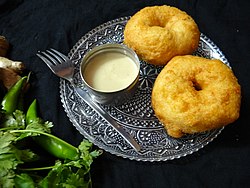Vadai

Medu vadas served with coconut chutney
|
|
| Course | breakfast, snack |
|---|---|
| Place of origin | India |
| Region or state | India, Sri Lanka, Singapore, Malaysia, Myanmar |
| |
|
| Nutritional value per 2 pieces (58 gm) | |
|---|---|
| Energy | 795 kJ (190 kcal) |
|
18
|
|
| Dietary fiber | 5 g |
|
11 g
|
|
| Saturated | 4 g |
|
4 g
|
|
| Minerals | |
| Sodium |
(20%)
306 mg |
|
Source:
|
|
|
|
| Percentages are roughly approximated using US recommendations for adults. | |
Vada [vəɽɑː] is a common term for many different types of savoury fried snacks from India. Different types of vadas can be described variously as fritters, cutlets, doughnuts, or dumplings. Alternative names for this food include wada, vade, vadai, wadeh and bara.
The various types of vadas are made from different ingredients, ranging from legumes (such as medu vada of South India) to potatoes (such as batata vada of West India). They are often eaten as breakfast or snack, and also used in other food preparations (such as dahi vada and vada pav).
According to K. T. Achaya, Vadai (Vada) was popular among ancient Tamils during 100 BCE-300 CE. A type of vada is mentioned as "vataka" in Manasollasa, a 12th century Sanskrit encyclopedia compiled by Someshvara III, who ruled from present-day Karnataka. In this recipe, green beans are soaked, de-skinned, and ground to a paste. The paste is shaped into balls and deep-fried. Early literature from present-day Bihar and Uttar Pradesh also mentions bara (vada) and mungaura (a vada made from mung).
Vadas may be made from legumes, sago or potatoes. Commonly used legumes include pigeon pea, chickpea, black gram and green gram. Vegetables and other ingredients are added to improve taste and nutritive value.
...
Wikipedia
